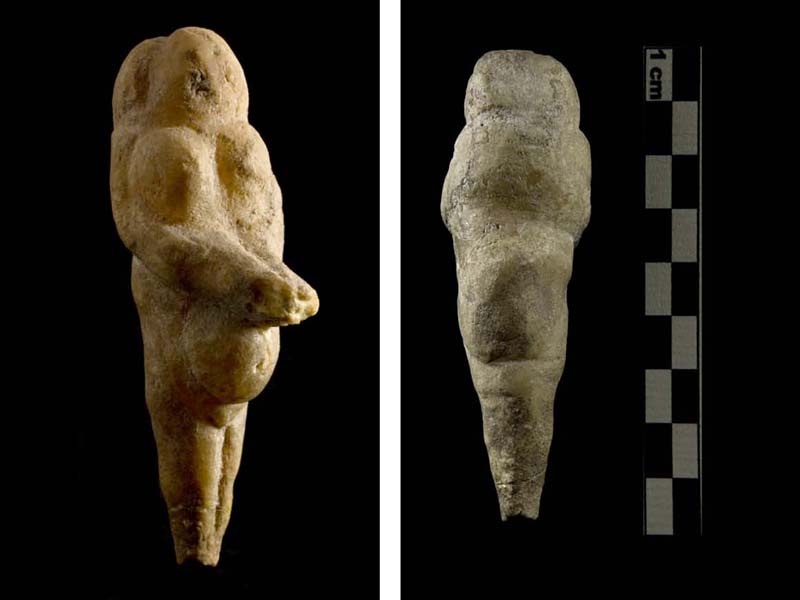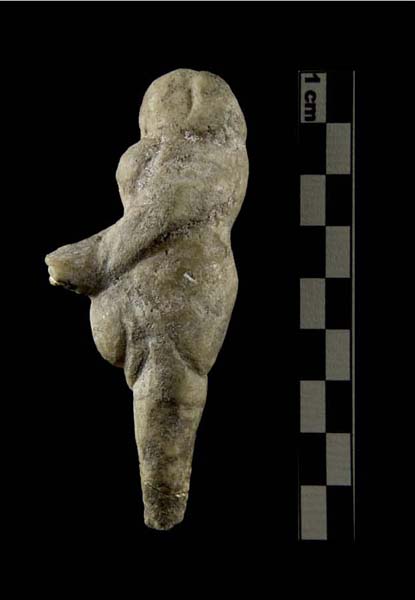Artifact made by working a stalactite, depicting a female body, probably pregnant, with a rounded and prominent belly shape, with a peculiar position of the hands, offering or gathering.
The belly is prominent and the pelvic area has the typical triangular shape, while the legs are traced and defined by a vertical incision.
The face is just shown. Her breasts are large and set high on her chest. A belly button is shown on the full abdomen and the vulva is clearly shown in relief. The legs taper to about the level of the knees, which are not shown, perhaps uncarved.
Most unusual is that the forearms extend well in front of the body, as if they are being used to hold something. The head appears to be sculpted in two portions, with a furrow between the front and back; it looks like he's wearing a headdress.
A suggestive hypothesis linked to the peculiarity of the gesture of "offering" or "collection" is that the artifact is found in caves known as galactophores, bearers of milk, considered magical and therapeutic as it was believed that the dripping water, if drunk from breastfeeding mothers, had the magical power to promote the secretion of milk. Precisely the raw material (a fragment of stalactite) and the position of the arms stretched forward, perhaps not so much as a sign of offering but rather to pick up something in the hands, could indicate the material and gestural connection with the water percolating from the cave. In terms of style and proportions, the statue falls within the typology of the Venuses of the Gravettian, a period that began about 28 years ago and ended 20 years ago.


Historical notes
The statuette was found during an excursion in 2007 by Sandro Polzinetti, speleologist and nature photographer, inside the complex called Grotte di Frasassi, a network of karst cavities, precisely in the cave called Beata Vergine di Frasassi, along the access leading into the cavity. The piece most likely came from the nearby wall with Pleistocene and Holocene deposits. Preliminary research focused on the geomorphology of the cavity to understand the context of the occupation. In addition, stylistic analyzes have been conducted and analyzes of the shaping techniques of the pieces are in progress.
The locality of Frasassi is famous throughout the world for its spectacular gorge almost three kilometers long, crossed by the Sentino river, between the Frasassi mountains and Monte Vallemontagnana. The Gorge is called della Rossa and connected to legends related to the great Mother. One of the best-known cavities is precisely the Grotta di Frasassi which is located a few kilometers from two important archaeological sites dating back to the Gravettian period, the localities of Ponte di Pietra and Fosso Mergoni, where some of the oldest traces of human presence in the Marche, dating back to about 20 thousand years ago. The cave, characterized by a large opening, is located at 310 m above sea level and about 100 m above the bed of the Sentino river, in the Frasassi gorge. The latter are carved into the Jurassic limestone intersected by river erosion. Along the walls of the gorge there are alluvial deposits dating back to the cold phases of the Pleistocene, subsequently engraved during the interglacial periods.
CARD
LATEST PUBLISHED TEXTS
VISIT THE FACTSHEETS BY OBJECT

